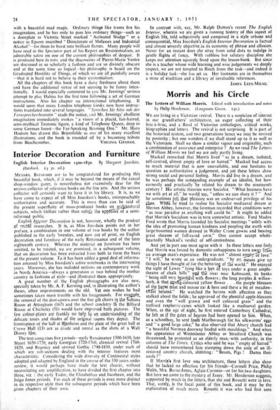Interior Decoration and Furniture
English Interior Decoration isoo-1830. By Margaret Jourdain. (Batsford. L3 35. od.) English Interior Decoration isoo-1830. By Margaret Jourdain. (Batsford. L3 35. od.)
MESSRS. BATSFORD are to be congratulated for producing this beautiful book, which, if it may be beyond the means of the casual shop-window gazer, is nevertheless not excessively dear for the serious collector of reference books on the fine arts. And the serious collector will certainly want to have it in his library. It is, as we have come to expect of all Miss Jourdain's books, unimpeachably authoritative and accurate. This is more than can be said of the present superfluity of mass-produced books on architectural subjects, which titillate rather than satisj)' the appetifes of a semi- informed public.
English Igjerier Decoration is not, however, wholly the product Of re:0111 researches. It is, as Miss Jourdain points out in her preface, a combination in one volume of two books by the author published in the early 'twenties, and now out of print, on English decoration and furniture of the early Renaissance and of the later eighteenth century. Whereas the material on furniture has been omitted, to be treated, we are promised, in a subsequent volume, that on decoration has been extracted from both to form the basis of the present volume. To it has been added a good deal of informa- tion amassed by Miss Jourdain's active notebooks in the intervening years. Moreover, she has included sections on contemporary work in North America—always a generation or two behind the mother country in fashions of style—and illustrated them appropriately.
A great number of the English photographs are also new, specially taken by Mr. A. F. Ktrsting and, in illustrating the author's theses, often improvements on the old. Yet one wishes he had sometimes taken more trouble with his foregrounds. For example, the removal of the dust-covers over the fine gilt chairs is the Sultana Room at Attingham (167) and the school crockery- Ifi the Billiard Room at Chicheley (51) would have improved both pictures. The few colour-plates are frankly no hclp to an understanding of the delicate tones and shades of the original rooms they depict. The frontispiece of the hall at Blenheim and the plate of the great hall at Crewe Hall (13) are as crude and unreal as the shots of a Walt Disney film.
The text comr rises five reriods—early Renaissance 1500-1650, late Stuart 1650-1720, early Georgian 1720-1760, classical revival 1760- 1820. and Regency and revived Gothic 1790-1830, under each of which are sub-sections dealing with the interior features most characteristic. Considering the wide diversity of Continental styles adopted and adapted by England in the course of the 330 years under review, it would perhaps have made the text clearer, without necessitating any amplification, to have divided the first chapter into three, viz. : the early Tudor, the Elizabethan and Jacobean, and the Inigo Jones periods. For each of these periods is even more distinct in its respective style than the subsequent periods which have been given chapters of their own.
In contrast with, say, Mr. Ralph Dutton's recent The English Interior, wherein we are given a running history of this aspect of English life, told subjectively and composed in a style urbane and consequential, Miss Jourdain's English Interior Decoration is factual and almost severely objective-in its economy of phrase and allusion. Never for an instant does she stray from solid data to indulge in gentle flights of fancy. With ruthless but salutary discipline she keeps our attention squarely fixed upon the lesson-book. But since she is a teacher whose wide learning and wise judgements we deeply respect. we are not tempted to flinch from the task—and indeed it is a holiday task--she has set us. Her footnotes are in themselves a mine of erudition and a library of invaluable references. JAMES LEES-M ILNE.






































 Previous page
Previous page